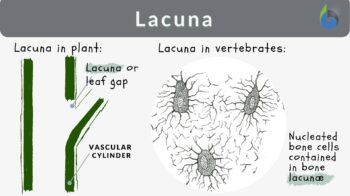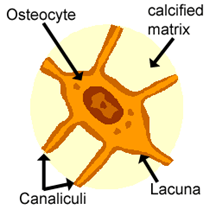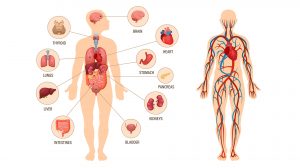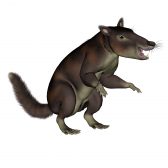
Lacuna
n., plural: lacunae or lacunas
[ləˈkuː.nə]
Definition: Literal Meaning: A gap or empty space; Biological meaning: cavity or gap or depression in an anatomical structure
Table of Contents
Definition of Lacuna
What is lacuna? The word “lacuna” (noun, plural: lacunae) is derived from the Latin word- ‘lacus‘, which means ‘a lake.’ Often, the words ‘lacuna’ and ‘lacunae’ are encountered in biology (including botany) and anatomy. Let’s see how these terms are used.
Lacuna in botany
In botany, the term “lacuna” refers to the gap in the vascular tissue of the stem through which a leaf grows. This gap is known as the leaf gap or lacuna. The connecting portion of a leaf to the stem is known as a leaf trace; a leaf trace grows through a lacuna or a leaf gap. Thus, the vascular stem tissue diverges into a leaf through a leaf lacuna. Characteristically, a leaf gap lacuna is present above the leaf trace (Figure 1). The presence of a leaf lacuna is a characteristic feature of angiosperms and few gymnosperms.

Lacuna in anatomy
What is a lacuna in anatomy? In anatomy, a lacuna is defined as the space housing the osteocytes in bones and chondrocytes in cartilage.
Lacunae Structure
Now that we know the definition of lacuna, let’s find out about the structures present in a lacuna. If a lacuna pertains to a gap, what can we find in a lacuna, particularly in bones and in cartilages?
Lacuna in bones
The primary cells of the bones are:
Osteoclasts are the bone cells that break down the bone tissues and function to repair and remodel the bone tissue. Osteoblasts originate from osteoprogenitor cells. They are the cells that line the bone surface and are responsible for collagen and organic matrix (i.e., osteoid) of the bone secretion. The osteoid is eventually calcified or undergoes ossification. Osteoblasts in the organic matrix transform into osteocytes. See Figure 2.

Osteocytes are the stellate-shaped bone cells that maintain bone tissue. Osteocytes form almost 95% of the bone tissue. Within the calcified matrix, the space occupied by the osteocytes is called lacuna. Thus, the lacunae of the osseous tissue contain osteocytes that prevent them from calcification.

Bone cells that become surrounded by the bone matrix and are located in cavities called lacunae are the osteocytes, which are stellate-shaped due to the several dendritic projections. The dendritic projections of the osteocyte cells pass through tiny channels called canaliculi (or small canals). These canaliculi serve the function of transportation of nutrients and waste and communicating with other osteocytes.
Each lacuna contains one osteocyte cell. The cell body of each osteocyte is enclosed in a lacuna having a diameter of 15–20 μm in diameter, while the dendritic projections of the osteocyte pass canaliculi (250–300 nm in diameter). Collectively, the osteocyte lacunae and canaliculi form the lacuna-canalicular system. This lacuna-canalicular network connects cells on the bone surface with the vasculature.
The canaliculi are filled with fluid known as canalicular fluid (or bone fluid). This fluid passes through the lacuna-canalicular space and immerses the osteocyte, supplying nutrients and oxygen required to maintain the osteocyte’s cell viability in a calcified environment. Also, the lacuna-canalicular system enables the transfer of biochemical signals between the osteocytes, thus, forming a functional network.

The bones are of two types: compact bones and spongy bones. The dense bones that can withstand high compressional forces are known as the compact bone whereas the bones with a highly porous structure that supports weight during the weight shift are known as the spongy or cancellous bone. The position of lacune differs in each type of bone.
The basic structural unit in a compact bone is known as the osteon (or Haversian system). Each osteon comprises concentric circles of a calcified matrix known as lamellae (singular: lamella). A central canal or Haversian canal passes through each osteon, through which blood vessels, nerves, and lymphatic vessels pass. The individual osteons also possess perforating canals known as Volkmann’s canals, through which blood vessels, lymph vessels, and nerves travel across the bone and eventually linking up with central canals. Compact bone is sometimes called cortical bone. The lacunae bone containing osteocytes are placed at the borders of adjacent lamellae, and the lacuna-canalicular system eventually connects with the central canal.

In a spongy bone, the lacunae housing osteocytes are not organized in concentric circles. Rather, the osteocytes containing lacunae are arranged in a lattice-like network in a matrix of spikes which is known as trabeculae. These trabeculae provide strength to the bone by forming stress lines.

Lacunae Cartilage
Cartilage is the avascular, flexible, semi-rigid connective tissue. Cartilages lack blood vessels and nerve supply. Cartilage is a highly flexible and robust tissue that can withstand high load. Cartilage is made up of chondroblasts, chondrocytes, and the extracellular matrix. Aggrecan (10%), water (75%), and a mixture of collagen fibers and other constituents make up the extracellular matrix of the collagen. The chondroblasts cells found in the outer layer of the cartilage secrete the extracellular matrix. Eventually, the chondroblasts cells get surrounded by the secreted extracellular matrix, where they mature and transform into chondrocytes. Chondrocytes occupy small spaces called lacuna wherein these chondrocytes lie. While growing, these chondrocytes divide and remain in close contact within an enclosed compartment referred to as lacuna. These lacunas can hold up to eight chondrocytes in each lacuna, known as cartilage cell clusters (Figure 7).

The repairing capabilities of the cartilage are limited because chondrocytes are present inside the lacunae and their migration to the damaged areas is not possible. Also, the lack of blood supply limits their repairing process.
Lacunae – Function
What is the function of a lacuna? The primary function of lacuna in bone or cartilage is to provide housing to the cells it contains and keeps the enclosed cells alive and functional. In bones, lacunae encase osteocytes; in cartilage, lacunae enclose chondrocytes.
The primary function of the lacuna in bones is to provide protection to the encased osteocytes from ossification and keep it alive and active. In cartilage, the lacuna not only encases the chondrocyte it also serves to provide nutrients required for their survival. Cartilage is an avascular structure, and lacuna containing extracellular matrix serves to provide the essential elements for the survival of the chondrocytes.
Lacunae – Dysfunction
Mineralization of the lacunae can severely impact bone function. With aging, generally, the mineralization of lacuna occurs, resulting in bone loss. Mineralization of osteocyte lacuna and the canaliculi is termed as micropetrosis.
In contrast to osteoblasts and osteoclast cells, osteocytes have a longer life. Osteocytes can live for years, whereas osteoblasts and osteoclasts survive only for a few days. Once the osteocyte cell dies, micropetrosis occurs, and the cell becomes a ‘living fossil’. Mineralized lacunae act as ‘plugs’ in the osteocyte lacuna-canalicular network that blocks the osteocytes’ fluid flow and nutrient supply. Due to the blocked nutrient supply, osteocyte viability is severely affected, resulting in localized network dysfunction. This localized dysfunctioning osteocyte network causes local mechanical imbalance, making the bones vulnerable to mechanical loading. Also, a reduced number of viable osteocytes severely affects the bone mechanosensitivity and delays the bone repair upon damage.
Mineralized lacuna is considered to be a vital sign of ‘aging’. It has been found that an age-dependent decrease in the density of the osteocyte lacunae occurs wherein an increased amount of hypermineralization of the lacuna with calcium phosphate occlusions occurs. The compromised lacuna-canalicular system in the aging and dying osteocyte produces fewer secretory factors, lower repair bone, and responds less to anabolic load. As a result, bones with mineralized lacunae exhibit increased fragility of bones even with small/low trauma. Apart from aging, hypermineralized lacune has also been observed in patients with osteoporosis. Patients with mineralized lacune exhibit brittle bones, which are highly prone to microcracking on small load exposure.
Interestingly, osteoporosis patients treated with bisphosphonates exhibit a reduced number of mineralized lacunae. Recent studies indicate the potential of using mineralized lacuna (density and extent) as an important indicator of bone quality. Bones with varied mechanical properties can be distinguished based upon the number of mineralized lacunae per bone area.
Try to answer the quiz below to check what you have learned so far about lacunae.
References
- Dallas, S. L., Prideaux, M., & Bonewald, L. F. (2013). The osteocyte: an endocrine cell … and more. Endocrine reviews, 34(5), 658–690. https://doi.org/10.1210/er.2012-1026.
- Bonewald L. F. (2017). The Role of the Osteocyte in Bone and Nonbone Disease. Endocrinology and metabolism clinics of North America, 46(1), 1–18. https://doi.org/10.1016/j.ecl.2016.09.003.
- Lotz, M. K., Otsuki, S., Grogan, S. P., Sah, R., Terkeltaub, R., & D’Lima, D. (2010). Cartilage cell clusters. Arthritis and rheumatism, 62(8), 2206–2218. https://doi.org/10.1002/art.27528.
- Florencio-Silva, R., Sasso, G. R., Sasso-Cerri, E., Simões, M. J., & Cerri, P. S. (2015). Biology of Bone Tissue: Structure, Function, and Factors That Influence Bone Cells. BioMed research international, 2015, 421746. https://doi.org/10.1155/2015/421746
©BiologyOnline.com. Content provided and moderated by Biology Online Editors.








